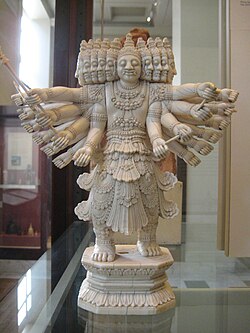
Back رافانا Arabic ৰাৱণ Assamese रावण AWA Rahwana BAN रावण Bihari রাবণ Bengali/Bangla ར་ལྦ་ན། Tibetan Rávana Czech Ravana German Ravano Esperanto
| Ravana | |
|---|---|
 Ravana, South India, 18th century CE | |
| Devanagari | रावण |
| Sanskrit transliteration | Rāvaṇa |
| Affiliation | Lanka, Rakshasa |
| Predecessor | Kubera (King of Lanka) |
| Successor | Vibhishana (King of Lanka) |
| Abode | Lanka |
| Mount | Pushpaka Vimana |
| Texts | Ramayana and its versions |
| Genealogy | |
| Parents | |
| Siblings | Kumbhakarna Vibhishana Shurpanakha half-brother - Kubera Kumbhini |
| Spouse | and Chitrangada |
| Children | Indrajita and Akshayakumara (by Mandodari) Narantaka, Devantaka, Atikaya and Trishira (by Dhanyamalini) Veerbahu (by Chitrangada) Mahiravana(spiritual sons) |
| Part of a series on |
| Hinduism |
|---|
 |
According to the Hindu epic, Ramayana, Ravana was a king[1][2] of the island of Lanka, in which he is the chief antagonist and is considered to be a Rakshasa (demon).[3][2] In the Ramayana, Ravana is described as the eldest son of sage Vishrava and Kaikasi. He abducted Rama's wife, Sita, and took her to his kingdom of Lanka, where he held her in the Ashoka Vatika.[4] Rama, with the support of vanara King Sugriva and his army of vanaras, launched a rescue operation for Sita against Ravana in Lanka. Ravana was subsequently slain, and Rama rescued his beloved wife Sita.[5][6]
Ravana was well-versed in the six shastras and the four Vedas, including the Shiva Tandava Stotra.[7] Ravana is also considered to be the most revered devotee of Shiva. Images of Ravana are often seen associated with Shiva at temples. He also appears in the Buddhist Mahayana text Laṅkāvatāra Sūtra, in Buddhist Jatakas, as well as in Jain Ramayanas. In Vaishnava scriptures, he is depicted as one of Vishnu's cursed doorkeepers.[8]
- ^ Justin W. Henry, Ravana's Kingdom: The Ramayana and Sri Lankan History from Below, Oxford University Press, p.3
- ^ a b Brown, Nathan Robert (2 August 2011). The Mythology of Supernatural: The signs and symbols behind the popular TV show. Berkley Boulevard books, Newwork. ISBN 9781101517529. Retrieved 12 May 2020.
- ^ Wheeler, James Talboys (1869). The History of India from the Earliest Ages. Vol. II The Rámáyana and the Vedic period. N. Trubner & Co. p. 281.
- ^ "Sunderkand explanation" (PDF). sunderkandsatsangsamuh.org. Archived from the original (PDF) on 18 July 2021. Retrieved 12 May 2020.
- ^ Das, Subhamoy. "The Ramayana". Learn Religions. Retrieved 12 May 2020.
Summary by Stephen Knapp
- ^ "Ravana". Encyclopædia Britannica. Retrieved 12 May 2020.
- ^ Vālmīki; Menon, Ramesh (26 May 2004). The Ramayana: A Modern Retelling of the Great Indian Epic. Macmillan. ISBN 978-0-86547-695-0.
- ^ Cite error: The named reference
Pankaj-2019-07-31-Stsmnwas invoked but never defined (see the help page).
© MMXXIII Rich X Search. We shall prevail. All rights reserved. Rich X Search